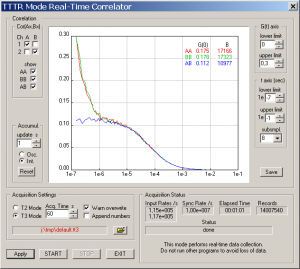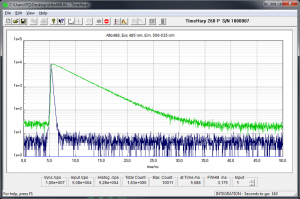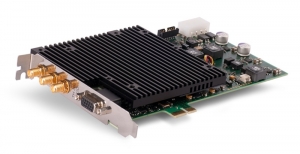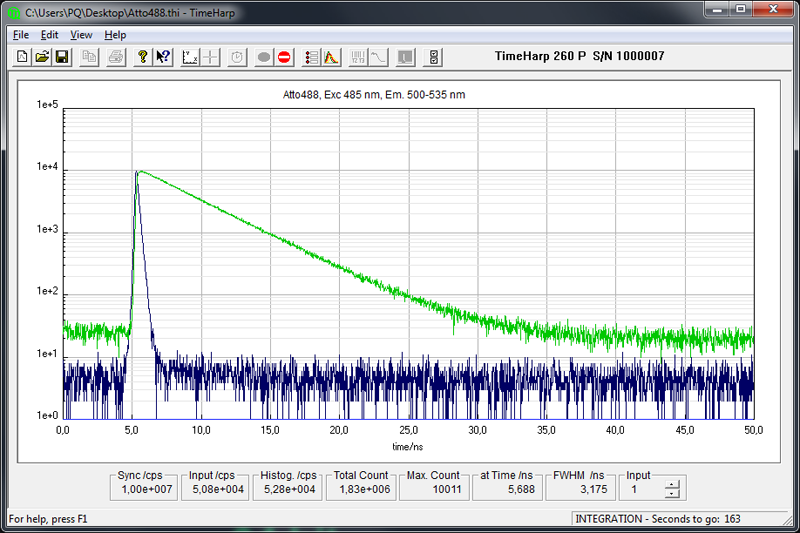TCSPC and Time Tagging Electronics
TimeHarp 260
TCSPC and MCS board with PCIe interface
- Ships within two weeks
- One or two independent input channels and common synch channel (up to 100 MHz)
- Two models with either 25 ps (PICO model) or 250 ps (NANO model) base resolution
- "Long range mode" option for PICO model with 2.5 ns base resolution
- Ultra short dead time (< 25 ns for PICO model, < 2 ns for NANO model)
- Time tagging with sustained count rates up to 40 Mcps
- 32 768 histogram channels
- Adjustable delay on each channel with 25 ps (PICO model) or 250 ps (NANO model) resolution
- Multi-stop capability for efficiency at slow repetition rates
- Programmable trigger output
- External synchronization signals for (fluorescence lifetime) imaging or other control events for modules with two detection channels
- NEW: Python wrapper snAPI for seamless communication, configuration, and data handling (optional drivers needed)
 The TimeHarp 260 is a compact, easy to use, Time-Correlated Single Photon Counting (TCSPC) and Multi-Channel Scaling (MCS) board for the PCIe interface. It is based in a custom TDC design that offers an ultrashort dead time even at high temporal resolutions. The board is available in two versions with either 25 ps (PICO module) or 250 ps (NANO module) base resolution. The high quality and reliability of the TimeHarp 260 is expressed by a unique 5-year limited warranty.
The TimeHarp 260 is a compact, easy to use, Time-Correlated Single Photon Counting (TCSPC) and Multi-Channel Scaling (MCS) board for the PCIe interface. It is based in a custom TDC design that offers an ultrashort dead time even at high temporal resolutions. The board is available in two versions with either 25 ps (PICO module) or 250 ps (NANO module) base resolution. The high quality and reliability of the TimeHarp 260 is expressed by a unique 5-year limited warranty.
Multiple input channels for highly flexible use
Each version of the TimeHarp 260 is available in different configurations with either one (SINGLE version) or two (DUAL version) independent detection channels and an additional common sync input. All of them, including the sync input, can be used as independent timing channels for coincidence correlation experiments. Alternatively the common sync input can be used for TCSPC with fast excitation sources. The other input(s) can then be used as independent detector channels for TCSPC. In this case the TimeHarp 260 allows forward start-stop operation at the full repetition rate of mode locked lasers with stable repetition rate up to 100 MHz.
PICO module for high resolution TCSPC
The TimeHarp 260 PICO is designed for high timing resolution. With a digital resolution of 25 ps and a timing jitter < 20 ps it is well matched to the timing resolution of the majority of common photon detectors. All input channels are equipped with software-adjustable Constant Fraction Discriminators (CFD) sensitive on the falling edge. The ultra short dead time of the TimeHarp 260 PICO of < 25 ns per channel allows very high measurement rates. Along with the extremely low differential non-linearity of the instrument, excellent data quality can be obtained.
The histogramming time range of the TimeHarp 260 PICO can be extended up to seconds with an optional "long range mode". In this mode the base resolution of the board is switched to 2.5 ns and the dead time reduces to < 2.5 ns. This permits to study dynamics from picoseconds up to seconds with just a single board.
NANO module for MCS and nearly deadtime-free correlation
The TimeHarp 260 NANO is designed for ultimately short dead time at a moderate time resolution. Exactly like the PICO model it can be used for coincidence correlations across all inputs or for TCSPC with light source trigger connected to the sync input. Because of the short dead time and the long histogram range it is particularly suited for classical Multi Channel Scaler (MCS) applications. Software-adjustable discriminators and polarity switches allow the TimeHarp 260 NANO to be interfaced to a wide range of signal and trigger sources. The board's multi-stop capability allows efficient recording of long-lived fluorescence and luminescence decays up to the seconds time range with correspondingly slow excitation rates, yet at very high detector count rates.
Adjustable delay in each input channel
Each input channel has an internal adjustable delay with ±100 ns range at either 25 ps resolution (PICO model) or 250 ps resolution (NANO model). This unique feature eliminates the need for specially adapted cable lengths or cable delays for changes in experimental set-ups.
Operation as time tagger
 A Time-tagged mode for recording of individual photon events with their arrival time on all channels allows the most sophisticated offline analysis of the photon dynamics. Time-Tagged Time-Resolved (TTTR) data can also be correlated in real-time for monitoring of FCS experiments at count rates up to 1 000 000 counts/sec. External marker signals are supported by the versions with two detection channels and can be used to synchronize the device with other hardware such as scanners, e.g., for Fluorescence Lifetime Imaging (FLIM).
A Time-tagged mode for recording of individual photon events with their arrival time on all channels allows the most sophisticated offline analysis of the photon dynamics. Time-Tagged Time-Resolved (TTTR) data can also be correlated in real-time for monitoring of FCS experiments at count rates up to 1 000 000 counts/sec. External marker signals are supported by the versions with two detection channels and can be used to synchronize the device with other hardware such as scanners, e.g., for Fluorescence Lifetime Imaging (FLIM).
Programmable trigger out
The TimeHarp 260 also features a trigger output, which can generate pulse periodes between 0.1 µs and 1678 s, corresponding to repetition frequencies between 0.596 Hz and 10 MHz. This feature can, e.g., be used to control external lasers.
| TimeHarp 260 PICO | TimeHarp 260 NANO | |
|---|---|---|
| Input channels and sync | Constant Fraction Discriminator (CFD) on all inputs, software adjustable | constant level trigger on all inputs, software adjustable |
| Number of detector channels (in addition to sync) |
1 (SINGLE) or 2 (DUAL) | 1 (SINGLE) or 2 (DUAL) |
| Input voltage range (pulse peak into 50 Ohms) | 0 to -1200 mV, optimum: -100 mV to -200 mV | -1200 mV to +1200 mV |
| Input voltage max. range (damage level) | ±1500 mV | ±2500 mV |
| Trigger edge | falling edge | falling or rising edge, software adjustable |
| Trigger pulse width | 0.5 to 30 ns | > 0.5 ns |
| Trigger pulse required rise/fall time | 2 ns max. | -- |
| Time to Digital Converters | ||
| Minimum time bin width | 25 ps in optional "long range mode": 2.5 ns |
250 ps* |
| Timing precision** | < 20 ps rms in optional "long range mode": < 1 ns rms |
< 250 ps rms* |
| Timing precision / √2** | < 14 ps rms in optional "long range mode": < 710 ps rms |
< 180 ps rms* |
| Dead time | < 25 ns in optional "long range mode": <2.5 ns |
< 2 ns |
| Peak count rate per input channel | 40 × 106 counts/sec in optional "long range mode": 400 × 106 counts/sec for bursts of up to 128 events |
1000 × 106 counts/sec for bursts of up to 96 events |
| Sustained count rate per input channel | 40 × 106 counts/sec | 40 × 106 counts/sec |
| Maximum sync rate (periodic pulse train) | 100 MHz | 100 MHz |
| Adjustable delay range for each input channel | ±100 ns, resolution 25 ps | ±100 ns, resolution 250 ps* |
| Differential non-linearity | < 2% peak, <0.2% rms (over full measurement range) | < 2% peak, <0.2% rms (over full measurement range) |
| Histogrammer | ||
| Count depth | 32 bit (4 294 967 296 counts) | 32 bit (4 294 967 296 counts) |
| Maximum number of time bins | 32 768 | 32 768 |
| Full scale time range | 819 ns to 1.71 s (depending on chosen resolution: 25 ps, 50 ps, 100 ps, ..., 52.42 µs) in optional "long range mode": 81.92 µs to 171 s (depending on chosen resolution: 2.5 ns, 5 ns, 10 ns, ..., 5242 ms) |
8.19 µs to 17.1 s (depending on chosen resolution: 250 ps, 500 ps,..., 524.2 µs)** |
| Acquisition time | 1 ms to 100 hours | 1 ms to 100 hours |
| Sustained throughput (sum of all channels)*** | typ. 30×106 events/sec (depending on host PC configuration and performance) | typ. 30×106 events/sec (depending on host PC configuration and performance) |
| TTTR Engine | ||
| T2 mode resolution | 25 ps in optional "long range mode": 2.5 ns |
250 ps* |
| T3 mode resolution | 25 ps, 50 ps, 100 ps,..., 52.42 µs in optional "long range mode": 2.5 ns, 5 ns, 10 ns, ..., 5 242 ms |
250 ps, 500 ps, 1 ns, ..., 524.2 µs* |
| FiFo buffer depth (records) | 8 388 608 | 8 388 608 |
| Acquisition time | 1 ms to 100 hours | 1 ms to 100 hours |
| Sustained throughput (sum of all channels)*** | typ. 40×106 events/sec | typ. 40×106 events/sec |
| Trigger Output | ||
| only available along with optional long range mode | always enabled | |
| Period | programmable, 0.1 µs to 1678 s (0.596 Hz to 10 MHz) | programmable, 0.1 µs to 1678 s (0.596 Hz to 10 MHz) |
| Pulse width (typical) | 10 ns | 10 ns |
| Baseline level (typical) | 0 V | 0 V |
| Active level (pulse peak) | -0.7 V | -0.7 V |
| External marker inputs | ||
| Number | 4 (only available in models with 2 detection channels) | 4 (only available in models with 2 detection channels) |
| Input type | TTL, < 10 ns rise/fall time, > 50 ns pulse width | TTL, < 10 ns rise/fall time, > 50 ns pulse width |
| Operation | ||
| PC interface | PCIe 2.0 x1 | PCIe 2.0 x1 |
| PC requirements | Dual core CPU (x86 chipset), min. 1.5 GHz CPU clock, min. 1 GB memory | Dual core CPU (x86 chipset), min. 1.5 GHz CPU clock, min. 1 GB memory |
| Operating system | Windows 8.1/10/11 | Windows 8.1/10/11 |
| Power consumption | ≤ 15 W (from PC internal power supply) | ≤ 15 W (from PC internal power supply) |
* applies to TimeHarp 260 Nano with base resolution = 250 ps (shipped after 2015). Earlier boards have a resolution of 1 ns but can be returned for an upgrade to 250 ps upon request.
** In order to determine the timing precision it is necessary to repeatedly measure a time difference and to calculate the standard deviation (rms error) of these measurements. This is done by splitting an electrical signal from a pulse generator and feeding the two signals each to a separate input channel. The differences of the measured pulse arrival times are calculated along with the corresponding standard deviation. This latter value is the rms jitter which we use to specify the timing precision. However, calculating such a time difference requires two time measurements. Therefore, following from error propagation laws, the single channel rms error is obtained by dividing the previously calculated standard deviation by √2. We also specify this single channel rms error here for comparison with other products.
*** Sustained throughput depends on configuration and performance of host PC
All Information given here is reliable to our best knowledge. However, no responsibility is assumed for possible inaccuracies or omissions. Specifications and external appearances are subject to change without notice.
Easy-to-use software and custom programming
 The TimeHarp 260 software for Windows provides functions such as the setting of measurement parameters, display of results, loading and saving of measurement parameters and measurement curves. Important measurement characteristics such as count rate, count maximum, position and peak width are displayed continuously. A comprehensive online help function shortens the users' learning curve. A library for custom programming, e.g., with LabVIEW is also available as an option. Software upgrades for extended functionality will be available with further product development.
The TimeHarp 260 software for Windows provides functions such as the setting of measurement parameters, display of results, loading and saving of measurement parameters and measurement curves. Important measurement characteristics such as count rate, count maximum, position and peak width are displayed continuously. A comprehensive online help function shortens the users' learning curve. A library for custom programming, e.g., with LabVIEW is also available as an option. Software upgrades for extended functionality will be available with further product development.
Measurement data from the TimeHarp 260 can be analyzed by different software packages. For multi-exponential reconvolution the EasyTau 2 software is an ideal tool. For the analysis of TTTR data (e.g., FLIM, FCS, FLCS, FRET, BIFL, etc.) the SymPhoTime 64 software suite is the tool of choice. Analysis of photon correlations is best performed with the QuCoa software package.
 Fast, intuitive, and versatile Python wrapper snAPI NEW
Fast, intuitive, and versatile Python wrapper snAPI NEW
snAPI serves as a bridge between the capabilities of PicoQuant's TCSPC devices and the Python ecosystem, offering efficient device communication, configuration, and data handling for all users.
Operation and Software Features (Current version: 3.2)
The TimeHarp 260 can be used in various operation modes:
Integration mode
Measurement of the accumulated events as a function of time, manually started, stopped manually or upon overflow or expiration of a chosen collection time or upon reaching of a defined number of counts. 512 curves with up to 65 536 time channels, more than 4 billion counts per time channel (32 bits).
Oscilloscope mode
Repetitive measurement and on-line display, very useful for optical alignment. Flicker free histogram display updates and large rate meters for work in the distance.
Time-Resolved Emission Spectra (TRES)
An optional hardware and software add-on allows to control a monochromator from within the TimeHarp software, allowing automated measurement of Time-Resolved Emission Spectra. This mode drives a monochromator via a stepper motor for collection of spectrally resolved lifetime histograms. Data is collected as in standard Integration Mode and saved in different blocks of memory for each wavelength. Four different monochromator types are currently supported: Sciencetech 9030, Sciencetech 9055, Acton Research SP-2155 and Acton Research SP-275.
Time-Tagged Time-Resolved mode(s) (TTTR)
 Continuously recording events without onboard histogramming straight to disk. Together with the channel number the arrival time of each event with respect to the beginning of the experiment is recorded for ultimate flexibility in offline data analysis, e.g., in single molecule detection and Burst Integrated Fluorescence Lifetime (BIFL) measurement as well as time-resolved FCS, coincidence correlation (antibunching, etc.) or time-interval analysis. A real-time correlator is included in the TTTR mode which can be extremely useful in setting up and monitoring of FCS experiments. Fast transfer and a large FIFO buffer allow huge count rates without any loss of data. Up to four different external synchronization signals ("markers") can be fed into the data stream and allow to synchronize the data acquisition with external hardware such as scanners for Fluorescence Lifetime Imaging (FLIM) (only supported by versions with two detection channels).
Continuously recording events without onboard histogramming straight to disk. Together with the channel number the arrival time of each event with respect to the beginning of the experiment is recorded for ultimate flexibility in offline data analysis, e.g., in single molecule detection and Burst Integrated Fluorescence Lifetime (BIFL) measurement as well as time-resolved FCS, coincidence correlation (antibunching, etc.) or time-interval analysis. A real-time correlator is included in the TTTR mode which can be extremely useful in setting up and monitoring of FCS experiments. Fast transfer and a large FIFO buffer allow huge count rates without any loss of data. Up to four different external synchronization signals ("markers") can be fed into the data stream and allow to synchronize the data acquisition with external hardware such as scanners for Fluorescence Lifetime Imaging (FLIM) (only supported by versions with two detection channels).
Software Overview
The TimeHarp 260 software allows the control of all measurement parameters provided by the TimeHarp 260 module. The input channels are programmable for a variety of signal types. All functions of the system are controlled by a software interface for Windows 8.1 and 10. The software provides functions such as the setting of measurement parameters, display of measurement results, loading and saving of measurement parameters and measurement curves. Important measurement characteristics such as count rate, count maximum and position, and histogram width (FWHM) are displayed continuously. A comprehensive online help function shortens the user's learning curve. Software upgrades for extended functionality will be available with further product development.
 A library (DLL) for custom program development for Windows and Linux is provided optionally and allows building your own applications, e.g., in LabVIEW , C++, Delphi, Python or MATLAB. Demo code is provided for an easy start. The libraries are API compatible, so that applications can easily be ported between platforms.
A library (DLL) for custom program development for Windows and Linux is provided optionally and allows building your own applications, e.g., in LabVIEW , C++, Delphi, Python or MATLAB. Demo code is provided for an easy start. The libraries are API compatible, so that applications can easily be ported between platforms.
Current software and Developer's Library version: 3.2
The new software version supports Windows 10 and the latest hardware improvement of the TimeHarp 260.
Time-Tagged Time-Resolved (TTTR) mode allows the recording of individual count events directly to hard disk or computer memory. The timing of each photon is captured as an event record without any early data reduction (such as on-board forming of histograms). This mode is particularly interesting where e.g. the dynamics in a fluorescence process are to be investigated in depth. The availability of the full timing information permits photon burst identification, which is of great value e.g. for single molecule spectroscopy in a liquid flow. Other typical applications are Fluorescence Correlation Spectroscopy (FCS) and Burst Integrated Fluorescence Lifetime (BIFL) measurements. Together with an appropriate scan controller, TTTR mode is also suitable for ultra fast Fluorescence Lifetime Imaging (FLIM) with unlimited image size. Applications beyond fluorescence spectroscopy are e.g. time interval analysis, quantum optics and related basic rearch. The TimeHarp 260 actually supports two different time-tagging modes, T2 and T3 Mode - a concept originally introduced with the PicoHarp 300 and HydraHarp 400. They differ slightly in their use of the input channels and by using the suitable mode, a very wide range of applications can be covered.
T2 Mode
In T2 Mode all signal inputs of the TimeHarp 260 are functionally identical. There is no dedication of one channel to a sync signal. All inputs can be used to connect photon detectors. The events from all channels are recorded independently and treated equally. In each case an event record is generated that contains information about the channel it came from and the arrival time of the event with respect to the overall measurement start. If the time tag overflows, a special overflow marker record is inserted in the data stream, so that upon processing of the data stream a theoretically infinite time span can be recovered at full resolution. Dead times exist only within each channel but not across the channels. Therefore, cross correlations can be calculated down to zero lag time. This allows powerful new applications such as FCS with lag times from picoseconds to hours to be implemented with one instrument. Autocorrelations can also be calculated at the full resolution but of course only starting from lag times larger than the deadtime.
T3 Mode
The T3 Mode is specifically designed to use periodic sync signals from pulsed lasers with high repetition rate up to 100 MHz. This signal is connected to the dedicated sync channel. As far as the experimental setup is concerned, this is similar to classic TCSPC in histogramming mode. In addition to the picosecond start-stop timing, the channel number is recorded and each event is time tagged with respect to the beginning of the experiment. The time tag is obtained by simply counting sync pulses. From the T3 Mode event records it is therefore possible to precisely determine which sync period a photon event belongs to. Since the sync period is also known precisely, this furthermore allows to reconstruct the arrival time of the photon with respect to the overall experiment time. If the counter overflows, a special overflow marker record is inserted in the data stream, so that upon processing of the data stream a theoretically infinite time span can be recovered.
External Event Markers
Both dual channel versions of the TimeHarp 260 support capturing up to four external marker events in the TTTR modes that can be fed to the instrument as TTL signals via a suited SubD connector. These events are recorded as part of the TTTR data stream. This allows to precisely synchronize the TTTR measurement with almost any experiment. The most important applications of this feature are FLIM and FRET imaging. This concept is used in the cutting-edge time-resolved mircroscope MicroTime 200.
Software Support
The acquisition software provided with the instrument comes with a rich set of demo programs that enable users to write their own analysis and display programs for TTTR data. Users who prefer to use standard data analysis algorithms out of the box may want to consider the powerful SymPhoTime 64 software suite. It implements a wide range of state-of-the-art analysis algorithms for FLIM, FCS and FRET to name only a few. Analysis of photon correlations for e.g. coincidence correlation or coincidence counting is best performed with the QuCoa software package.
The TimeHarp 260 can be used for various applications that can make use of a multi-channel TCSPC and/or time tagging system with independent channels, such as:
- Time-Resolved Fluorescence
- Fluorescence Lifetime Imaging (FLIM)
- Phosphorescence Lifetime Imaging (PLIM)
- Fluorescence Correlation Spectroscopy (FCS)
- Fluorescence Lifetime Correlation Spectroscopy (FLCS)
- Foerster Resonance Energy Transfer (FRET)
- Stimulated Emission Depletion Microscopy (STED)
- Dual Focus Fluorescence Correlation Spectroscopy (2fFCS)
- Pulsed Interleaved Excitation (PIE)
- Fluorescence Anisotropy (Polarization)
- Single Molecule Spectroscopy / Detection
- Singlet Oxygen
- Time-Resolved Photoluminescence (TRPL)
- TRPL Imaging
- Lanthanide Upconversion
- Bunch Purity
- LIDAR/Ranging/SLR
- Antibunching
- Coincidence Correlation
- Quantum Communication
- Quantum Entanglement
- Quantum Teleportation
- Quantum Information Processing
- Positron Annihilation Lifetime Spectroscopy (PALS)
- Time response characterization of optoelectronic devices
- Thomas-Bollinger single photon method
- Muon lifetime experiments
The following documents are available for download:
- Datasheet TimeHarp 260
- Brochure about PicoQuant's photon counting and timing products
- Technical note: Time-Correlated Single Photon Counting (TCSPC)
Latest 10 publications referencing TimeHarp 260
The following list is an extract of 10 recent publications from our bibliography that either bear reference or are releated to this product in some way. Do you miss your publication? If yes, we will be happy to include it in our bibliography. Please send an e-mail to info@picoquant.com containing the appropriate citation. Thank you very much in advance for your kind co-operation.




 Get in touch
Get in touch




